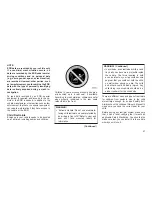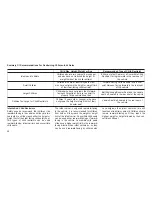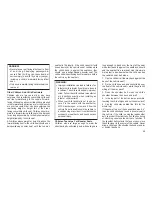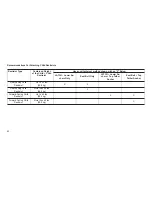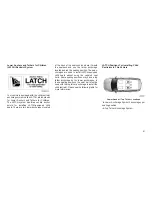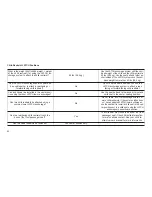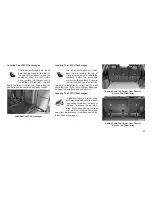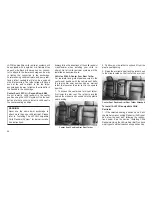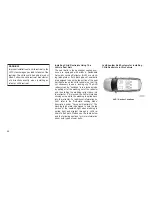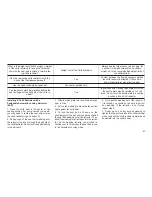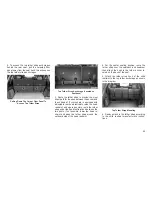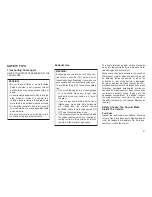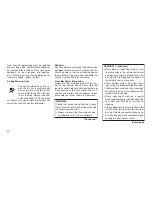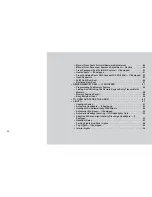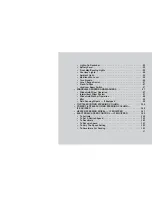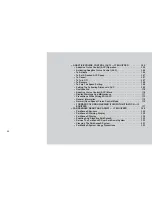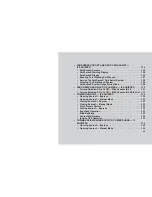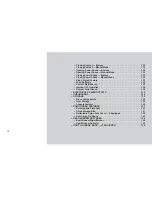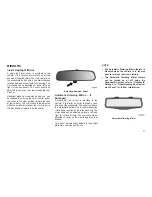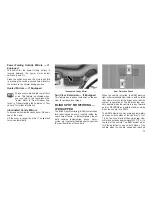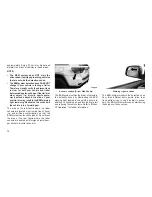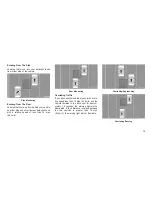
SAFETY TIPS
Transporting Passengers
NEVER TRANSPORT PASSENGERS IN THE
CARGO AREA.
WARNING!
•
Do not leave children or animals inside
parked vehicles in hot weather. Interior
heat build-up may cause serious injury or
death.
•
It is extremely dangerous to ride in a cargo
area, inside or outside of a vehicle. In a
collision, people riding in these areas are
more likely to be seriously injured or killed.
•
Do not allow people to ride in any area of
your vehicle that is not equipped with seats
and seat belts.
•
Be sure everyone in your vehicle is in a
seat and using a seat belt properly.
Exhaust Gas
WARNING!
Exhaust gases can injure or kill. They con-
tain carbon monoxide (CO), which is color-
less and odorless. Breathing it can make you
unconscious and can eventually poison you.
To avoid breathing (CO), follow these safety
tips:
•
Do not run the engine in a closed garage
or in confined areas any longer than
needed to move your vehicle in or out of
the area.
•
If you are required to drive with the trunk/
liftgate open, make sure that all windows
are
closed
and
the
climate
control
BLOWER switch is set at high speed. DO
NOT use the recirculation mode.
•
If it is necessary to sit in a parked vehicle with
the engine running, adjust your heating or
cooling controls to force outside air into the
vehicle. Set the blower at high speed.
The best protection against carbon monoxide
entry into the vehicle body is a properly main-
tained engine exhaust system.
Whenever a change is noticed in the sound of
the exhaust system, when exhaust fumes can
be detected inside the vehicle, or when the
underside or rear of the vehicle is damaged,
have a competent mechanic inspect the com-
plete exhaust system and adjacent body areas
for broken, damaged, deteriorated, or misposi-
tioned parts. Open seams or loose connections
could permit exhaust fumes to seep into the
passenger compartment. In addition, inspect
the exhaust system each time the vehicle is
raised for lubrication or oil change. Replace as
required.
Safety Checks You Should Make
Inside The Vehicle
Seat Belts
Inspect the belt system periodically, checking
for cuts, frays, and loose parts. Damaged parts
must be replaced immediately. Do not disas-
semble or modify the system.
61
Summary of Contents for Grand Cherokee SRT 2014
Page 1: ......
Page 3: ......
Page 4: ......
Page 6: ...2...
Page 11: ...7...
Page 68: ...64...
Page 154: ...INSTRUMENT CLUSTER 150...
Page 203: ...Control Setting Suggestions for Various Weather Conditions 199...
Page 204: ...200...
Page 276: ...272...
Page 330: ...326...
Page 331: ...8 MAINTENANCE SCHEDULES MAINTENANCE SCHEDULE 328 327...
Page 332: ...MAINTENANCE SCHEDULE Refer to the Service and Warranty Handbook for maintenance schedules 328...
Page 333: ...9 IF YOU NEED CONSUMER ASSISTANCE IF YOU NEED ASSISTANCE 330 329...
Page 335: ...331...
Page 336: ...332...
Page 337: ...10 INDEX 333...

